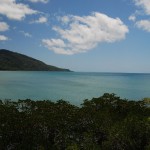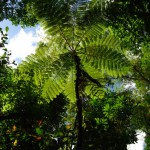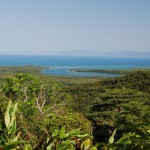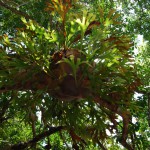Daintree National Park
We devoted our second day in Cairns to Daintree National Park, in which the planet’s oldest rainforest grows.
Daintree National Park received its name from the eponymous river and city that bear the name of Richard Daintree, a geologist who explored Northern Queensland in the 1860s. The National Park is located in the north of Australia, in Queensland State, 100 kilometers away from Cairns. The total area of the National Park is approximately 76,000 hectares.
Daintree National Park was founded in 1981; and in 1988 the park was added to the UNESCO list of the World Heritage objects. One part of the park that is called Cape Tribulation is one of the rarest places, where the tropical rainforest extends to the ocean coast. Captain Cook called this place “Cape of Tribulation” in bitter confession of the hardships he had to overcome as his ship passed through the Great Barrier Reef. The major section of the park is located deep inland, far from the cape. Mainly, it has a mountainous landscape that is hard to reach, covered with evergreen woods.
Most of the territory of Daintree National Park is covered by the world’s oldest rainforest. According to some scientists, rainforest has been in this region for up to one hundred million years – since the time, when the Australian continent separated from the ancient super-continent Gondwana.
What makes the territory of Daintree National Park unique is the recently discovered tree and plant species of this virgin land that were believed to be extinct; as well as scenic Mossman Gorge, which is located at the southern end of the National Park, the Cape of Tribulation and the proximity of the park to the Great Dividing Range. The Daintree River is the heart of the park; the river originates near the Great Dividing Range and as it runs through the rainforest it flows into the Coral Sea. If you happen to be in the forest during the rain season, you can see how the streams of warm rainwater rush down, making their way through the trees.
In the thick of the virgin forest you can see the most fantastic creatures: luminescent green frogs with tentacle-lamps climbing up the trees; opossums gliding from one tree to another, marsupial cats; and in April – luminescent mushrooms that grow on the trunks of the trees. One can judge concerning the variety of species that live in the park based upon this interesting statistics: one third of all frog, reptile and marsupial species live here; close to 70% kinds of mice and butterflies; 20% kinds of birds, including those that migrate. And all of it is despite the fact that the territory of the national park only covers 0.2% of the entire Australian territory.
Daintree National Park is also famous for a sacred place of local aborigines that is called the “Bouncing Stones,” which is located on its territory at Thornton Beach. This is a rather quiet beach, which is believed to be a very important sacred place by the Kuku Yalanji aboriginal people. Women of the Kuku Yalanji tribe perform their secret magic rituals at Thornton Beach, because of which the entire beach is under a curse. There is a belief, according to which if someone takes even one stone for himself from this beach, he will invoke upon himself the wrath of ancient spirits and that person will be cursed for the rest of his or her life.
Among local fauna the most noteworthy one for its beauty and rareness is the Fruit Pigeon called Wompoo. Emus and cassowary are also quite common here.





